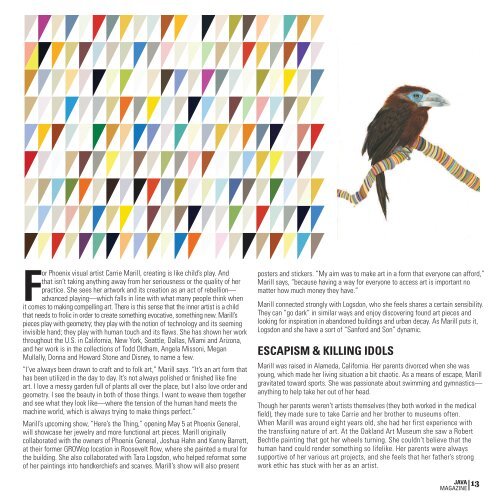You also want an ePaper? Increase the reach of your titles
YUMPU automatically turns print PDFs into web optimized ePapers that Google loves.
For Phoenix visual artist Carrie Marill, creating is like child’s play. And<br />
that isn’t taking anything away from her seriousness or the quality of her<br />
practice. She sees her artwork and its creation as an act of rebellion—<br />
advanced playing—which falls in line with what many people think when<br />
it comes to making compelling art. There is this sense that the inner artist is a child<br />
that needs to frolic in order to create something evocative, something new. Marill’s<br />
pieces play with geometry; they play with the notion of technology and its seeming<br />
invisible hand; they play with human touch and its flaws. She has shown her work<br />
throughout the U.S. in California, New York, Seattle, Dallas, Miami and Arizona,<br />
and her work is in the collections of Todd Oldham, Angela Missoni, Megan<br />
Mullally, Donna and Howard Stone and Disney, to name a few.<br />
“I’ve always been drawn to craft and to folk art,” Marill says. “It’s an art form that<br />
has been utilized in the day to day. It’s not always polished or finished like fine<br />
art. I love a messy garden full of plants all over the place, but I also love order and<br />
geometry. I see the beauty in both of those things. I want to weave them together<br />
and see what they look like—where the tension of the human hand meets the<br />
machine world, which is always trying to make things perfect.”<br />
Marill’s upcoming show, “Here’s the Thing,” opening May 5 at Phoenix General,<br />
will showcase her jewelry and more functional art pieces. Marill originally<br />
collaborated with the owners of Phoenix General, Joshua Hahn and Kenny Barrett,<br />
at their former GROWop location in Roosevelt Row, where she painted a mural for<br />
the building. She also collaborated with Tara Logsdon, who helped reformat some<br />
of her paintings into handkerchiefs and scarves. Marill’s show will also present<br />
posters and stickers. “My aim was to make art in a form that everyone can afford,”<br />
Marill says, “because having a way for everyone to access art is important no<br />
matter how much money they have.”<br />
Marill connected strongly with Logsdon, who she feels shares a certain sensibility.<br />
They can “go dark” in similar ways and enjoy discovering found art pieces and<br />
looking for inspiration in abandoned buildings and urban decay. As Marill puts it,<br />
Logsdon and she have a sort of “Sanford and Son” dynamic.<br />
ESCAPISM & KILLING IDOLS<br />
Marill was raised in Alameda, California. Her parents divorced when she was<br />
young, which made her living situation a bit chaotic. As a means of escape, Marill<br />
gravitated toward sports. She was passionate about swimming and gymnastics—<br />
anything to help take her out of her head.<br />
Though her parents weren’t artists themselves (they both worked in the medical<br />
field), they made sure to take Carrie and her brother to museums often.<br />
When Marill was around eight years old, she had her first experience with<br />
the transfixing nature of art. At the Oakland Art Museum she saw a Robert<br />
Bechtle painting that got her wheels turning. She couldn’t believe that the<br />
human hand could render something so lifelike. Her parents were always<br />
supportive of her various art projects, and she feels that her father’s strong<br />
work ethic has stuck with her as an artist.<br />
JAVA 13<br />
MAGAZINE


















